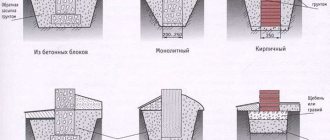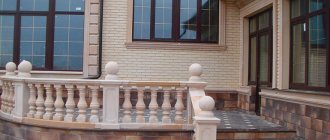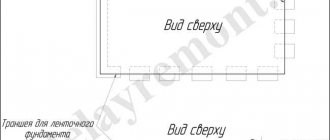Truck-mounted concrete pumps (concrete pumps) are actively used in monolithic construction; they solve the problem of supplying mortar to the upper floors of structures under construction. Concrete pump is a construction equipment for receiving concrete into a special ABS bunker and then delivering it to the place of placement.
Zoomlion 38X-5RZ (ZLJ5296THB-38X-5RZ) - Concrete pumping vehicle (38 m) based on the Mercedes-Benz Actros 3340 chassis
Application of concrete pumps in construction
Concrete pumps are widely used for the construction of monolithic high-rise buildings. Thanks to the installations, concrete is delivered to different heights, which reduces time and physical costs. The concrete pipeline ensures rapid supply of concrete mixture during the construction of bridges. Water and railway structures are built with its use. The concrete supply unit is used in the construction of port and tunnel connections.
In private construction, special equipment is not always used, which is explained by the limited access of special equipment. To simplify the task and speed up the construction process, the use of mini concrete pumps is recommended.
Potential problems
Using a concrete pumping station significantly increases the speed of construction. But you need to be prepared for the fact that in the process of servicing these devices you will have to face some difficulties. The most popular among them:
- Overload and motor failure. This is one of the most common problems. To avoid this, it is necessary not to give the engine excessive speed. An indicator of normal functioning is the absence of vibration;
- Engine overheating. It is necessary to keep the temperature around 70-80 degrees. If it rises higher, let it cool;
- Wear of some parts. The chemical properties of concrete, as well as increased mechanical stress, lead to the fact that rubber parts may lose their properties. There is only 1 solution - you need to have a sufficient supply of consumables.
Considering these nuances, as well as the cost of concrete pumps, the question of self-assembly of the device naturally arises.
Principle of operation
To determine the principles of operation of a concrete pump, you need to understand its structure. The equipment has a mixer, wheels, a lubrication system, an outlet, supports, and a loading hopper. The equipment also consists of a cooling system, a gate valve, an oil tank, and a lubrication system. The concrete pump has a tool box, a pressure gauge, a pumping valve, a hydraulic system, an oil filter, a casing, an electrical panel, a chassis, and a tow hitch. The concrete drainage device consists of:
- Concrete drainage elbow;
- Flushing device;
- Concrete drainage pipe;
- Concrete drainage lock with rubber seal.
The main unit of construction equipment is an engine of varying power, which can be electric or diesel. The pumping system operates via an open circuit, which is subject to adjustment.
Thanks to the universal design of the concrete pump, stepless hydraulic adjustment is possible. The amount of fuel supplied can be adjusted. The installation consists of a water pump and two hydraulic cylinders. The last of them connect the pistons, which leads to reciprocating movements. This process consists of the pistons moving in different directions.
The flow of concrete mixture from the outlet openings is carried out into the loading sector. It is pumped by two cylinders that move in different directions. Suction and injection of the mixture is ensured by the connection of transport and hydraulic cylinders.
Delivery by crane and lifts
Concrete cranes are tower or boom mechanisms equipped with a bucket for cement mortar. The peculiarity of these self-propelled devices is the dosed supply of the mixture into the masonry block and its subsequent distribution. Cement can be moved in horizontal and vertical planes.
There are two types of special tubs:
- non-rotating feed tub, feed with its help is carried out only in the horizontal plane;
- rotating tub equipped with a vibrator. It is distinguished by the possibility of horizontal loading and vertical movement with further unloading to different heights.
Special lifts are designed for strictly horizontal movement of concrete. For example, rack devices equipped with buckets or containers lift the mixture for laying interfloor floors. Wheelbarrows, carts and scooters are used for transportation between building blocks.
Return to contents
Advantages of automatic concrete pumps
The concrete pump has excellent technical characteristics and has many advantages:
- Ensuring a continuous installation process. When concreting is stopped, a decrease in the quality of the finished material is observed, since concrete mixtures of different levels of hardening do not adhere well to each other.
- Pipes for the concrete pump ensure the supply of the mixture to a height. The installations provide the ability to move a large volume of mixture in the shortest possible time.
- The operating principle of a concrete pump significantly reduces time and labor costs when supplying the mixture to a construction site.
- It is possible to use the equipment for partial construction of structures.
- Compared to belt conveyors, concrete pipelines are characterized by compactness.
- The units are characterized by ease of installation, which speeds up the construction process.
- During the supply of mixtures, water losses are minimized, which has a positive effect on the quality of concrete. This aspect is important when it is necessary to transport the mixture over significant distances.
The characteristics of concrete pumps allow them to be used during complex construction.
Transportation by pipeline
Concrete injection pipelines are increasingly being used on modern construction sites. This delivery method has a number of advantages. First of all, it is possible to transport the mixture both vertically to different heights and horizontally to any distance. Concrete pipes (hoses) can be used to pump cement even into hard-to-reach places. If there is a concrete mixing plant on site, the process is carried out continuously. For this, one hose or pipeline is used, which significantly reduces the time spent and the cost of work.
The only need is to use special pumps to pump solutions to the masonry site. These include pneumatic blowers, concrete pumps and other transport communications. The most popular are oil-hydraulic driven pumps. Mechanical superchargers are less popular due to faster wear. These devices are connected to supply hoses or steel concrete pipes into which cement is pumped from the concrete mixer.
Return to contents
Flaws
Concrete pumps have certain disadvantages that need to be taken into account when purchasing.
This technology is expensive and is not available to all users and companies.
But, with its regular use in construction, it justifies itself. When operating the equipment, it is necessary to install a concrete pipeline. A pipe system on the boom solves the problem.
If there is a need for spot filling of small areas, for example, when installing a prefabricated monolithic structure, this equipment is not advisable to use. During long-term operation of the installations, wear of the pump mechanism and pipe is observed.
Mobile and stationary concrete pumps
Dynamic
These are the devices that are built on the basis of a truck. This is done in order to move the finished mixture over long distances.
The two main elements of such a pump are:
- Pumping station consisting of a hopper and an engine;
- Arrow. This part is a steel pipe from 10 to 60 meters. It consists of several segments connected to each other by movable metal parts.
The advantages of using this type are as follows:
- Has high performance. In 1 hour it is capable of pumping more than 90 cubic meters of mixture;
- Does not require a large staff of specialists for maintenance. The working team of this apparatus consists of 2 people. One controls the boom, the second is responsible for concrete work.
Stationary
This pumping unit cannot move independently. It was this fact that gave rise to the name. In order to move it around the construction site, you will need a car. From a technical point of view, a stationary concrete pump is a system consisting of a motor, a hopper and a pipe system located on a chassis.
Its advantage is its great functionality - it is suitable for almost any type of work, it can convey the composition horizontally. Moreover, its cost is several times less than the type described below.
Mobile automobile and stationary concrete pumps are the main ones. However, there are some other modifications. For example, in mini format. Mobility is not the only species characteristic. The internal structure is no less important.
Problems that may arise when laying using concrete pumps
The installation uses pressure to deliver the concrete mixture to a height. When the equipment is used incorrectly, certain problems occur:
- If the speed of laying the mixture increases, then the formation of cavities is observed in the monolith, especially when using a fine mesh for reinforcement. That is why during work you need to ensure that the mixture is supplied evenly.
- If a surface vibrator is used for compaction rather than a deep one, then the mixture must be placed in a small volume. When carrying out work, compaction of each layer is a prerequisite.
- During work, it is recommended to carefully fix the reinforcement frame, since the flow of concrete can disrupt it.
- After completing the work, you need to wash the concrete pipeline pipes, as well as the pump.
- If the concrete pump has a high capacity, then builders must hold the flexible end while operating it.
- To avoid traffic jams, it is strictly forbidden to take long breaks from work.
- If plugs form in the concrete pipeline, this can lead to damage to the pump mechanisms. At the initial stage of plug formation, the pump is reversed. You can disconnect the section and clean the pipes manually.
Mobile mini-stations
The technology used for laying concrete is complex and expensive. To justify the purchase and make a profit, it must operate at maximum capacity. On large construction sites, heavy-duty, productive ABS pays off. In low-rise construction, it is better to use the mini type of equipment.
When choosing equipment, pay attention to the technical capabilities of small-sized installations. Self-propelled units have high maneuverability, which is important for narrow streets in old buildings.
If the ABN on the KamAZ platform requires a turning area of 10-12 m2, for small-sized equipment you need 2 times less. Considering that the height of the structure does not exceed 6 meters, mini-equipment can be installed indoors in a closed production area.
The equipment is multifunctional; it can work on ready-made concrete poured into a bunker or prepare a building mixture from dry components in it, if a mixer is included in the kit.
To service the ABN, 5-6 auxiliary workers are required; the mini station is served by a driver and a worker.
Technical characteristics of mini concrete pumps:
- Types of pumps – rotary and piston.
- Stationary and mobile pulp pumping stations.
- Engine: diesel or electric.
- The maximum horizontal pumping distance is 150 meters.
- The maximum injection height is 50 meters.
- capacity options 5-62 m3/hour.
- High maneuverability.
Often the capabilities of such equipment are sufficient for the construction of low-rise buildings. There is a peculiarity - all pumping processes must be completed within 20 minutes, after which the labyrinths must be washed under pressure.
The average weight of a stationary unit is about a ton; it can be delivered to the site by light-duty transport. The cost of renting or purchasing a mini-concrete pump pays off within 6-8 months, provided it is fully loaded. When choosing equipment, you need to remember that a piston pump is 2 times more productive than a rotary pump. However, the rotary one operates with low noise and pumps the thick mass evenly without pulsation.
Unit types
Depending on how concrete pumps work, they are divided into several types. Pumping of liquid is carried out using ejection, membranes, centrifugal force, etc.
Operation of the piston system
A piston pump is the most popular equipment, which consists of cylinders and pistons. When they move, the moving medium is captured and pushed out. The concrete is stored in special bunkers with a capacity of 12-15 cubic meters, which ensures continuous operation. An additional mixing device is installed in the hopper, which eliminates the possibility of mixture stratification.
The cylinder and the pump receiver are connected to each other using a valve, which opens when the piston returns, which ensures the flow of concrete mixture. If a straight stroke of the piston is observed, this leads to the mixture being pushed into the concrete pipeline.
The installation is often called a hydraulic pump, since the movement of the pistons is ensured by hydraulic cylinders. The oil flow in them is controlled by a distributor. The gates open and close hydraulically.
Using the equipment, good pressure of the concrete mixture is ensured, as it has high productivity.
Rotor system operation
The equipment has a simple design. His work is based on the method of squeezing out a concrete mixture. The equipment consists of a receiving hopper, a rotor, which is equipped with rollers and a drive, and a housing.
Compared to a piston system, a rotary pump creates less pulsation at the outlet. The equipment creates a minimal amount of noise during operation, which ensures ease of use. The units are lightweight and small in size, which guarantees their convenient operation.
The disadvantage of rotary systems is that they cannot transport mixtures with large inclusions. Compared to piston designs, they create less pressure. The flexible part of the pressure section wears out quite quickly.
Using Belt Conveyors
Using belt conveyors to supply concrete.
This type of device is used in industrial and residential construction, the plan of which includes the construction of small point structures. Mobile conveyors are equipped with a smooth or ribbed belt 6-15 m long, 40-50 cm wide. The pouring height can be changed in the range from 1.5 to 4 m. The peculiarity of conveyor pouring is the possibility of carrying out a continuous process. In this case, the mixture of the required thickness flows evenly.
The advantage of the conveyor is to minimize solution losses by organizing the process of self-cleaning of the belt with the return of the remaining fill to the dispensing unit.
However, this method has some nuances. Strict adherence to the instructions helps prevent the possibility of mixture separation. For example, the pour movement should be 6 cm or less. The angle of inclination of the belt on ascent and descent for a mixture with mobility up to 4 cm should be 18° and 12°, respectively. With this parameter, in the range of 4-6 cm, you can raise the tape up to 15°, and lower it up to 10°. In this case, the feed belt must move at a speed of less than 1 m/s. For unloading, guide plates with a canopy height of more than 0.6 m should be used. In this case, cement should not flow from the transporter.
The disadvantages of such an organization of the solution delivery process include the inability to distribute concrete over the concrete site. If a large area is being processed, conveyors must be moved manually, which causes additional labor costs and delays construction.
Concrete pavers are the most effective. These machines are recommended for use for laying monolithic foundations for buildings and technological equipment. A concrete paver is a machine equipped with a rotating platform, a device for receiving and pouring cement into concreting areas on a telescopic belt conveyor.
Return to contents
Unit mounting options
Types of concrete pumps are determined in accordance with the features of their installation. They can be stationary or mobile.
Stationary pumps
Among the various units, stationary pumps are popular in the construction of large objects. They have little mobility. The units are mounted on a wheeled chassis, which allows them to be moved.
Fixed brands of concrete pumps are produced, which are installed on a durable base. The scope of their application is factories of reinforced concrete products. Such equipment supplies the concrete mixture to a great height. The pump is driven by an internal combustion engine, which can be electric, gasoline or diesel.
Stationary concrete pipelines are characterized by high productivity, so they are used when necessary to perform large volumes of work. The installations are used in large-scale construction.
Concrete pump sb 207a
Pumps on a car base
Automotive concrete pumps are most often mounted on trucks. The power take-off shaft provides the equipment drive. Hydraulic transmission can also be used in installations.
In Moscow and the CIS you can find self-propelled units on a tracked chassis. They are used when it is impossible for standard equipment to enter a construction site.
Truck-mounted concrete pumps are characterized by the presence of a retractable, controlled boom, which is equipped with a concrete pipeline. The boom reach can be more than 30 meters. We produce equipment based on a concrete mixer.
Recommendations for choosing concrete pumps
First of all, you need to decide whether the equipment will be purchased or rented. You have a large construction company, concreting work - the main technological process - stationary concrete pumps on a wheeled trailer - the best equipment. Low-rise, scattered construction sites - ABN can help you.
For the construction of individual objects, where it is impossible to ensure a constant load on the equipment, it is profitable to rent a concrete pump.
Specialized stores sell new and used equipment from different manufacturers. It is important for you to choose a concrete pump according to your request. ABS is more expensive - the equipment is non-removable and installed on the chassis of a truck.
Important selection criteria:
- type of concrete pump - piston or rotary;
- power of the power plant or engine;
- pressure and distance of pumping concrete mixture;
- solution productivity;
- pipe pressure;
- manufacturer.
Check what permissible granule size the manufacturer has included in the technical characteristics, climatic and other operating features of the equipment.
It is more profitable to rent equipment. If the unit does not fit, it can be replaced. Maintenance, management and troubleshooting are usually the responsibility of the landlord.
Buy or do it yourself
A concrete pump is an expensive piece of equipment that can be purchased at a specialty store. If there is a lack of funds, you are given the opportunity to install the equipment yourself. When choosing settings, it is recommended to follow certain rules:
- Initially, the functional load of the equipment and its compliance with the construction work being performed is determined.
- If the need for a concrete pump arises 1-2 times during construction, it would be better to rent it.
- The selection of parameters for the length and height of supply of the concrete mixture is carried out individually.
- During the selection period of equipment, the characteristics of its power and its productivity are determined.
- Experts recommend giving preference to mobile installations, since during the construction of various objects there is a need to use additional equipment for transporting stationary installations.
The most popular brands include
Chinese concrete pump Sany
. They are easy to use and durable. The installation is controlled remotely using a special remote control. There is no significant noise generated during operation of the equipment. The concrete supply speed in the installation can be adjusted.
Italian concrete pump Cifa
fully meets modern construction technologies. High-performance components are used to complete it. Thanks to the presence of a bunker in the installation, the quality of concrete improves. The installation is compact, which allows it to be used on construction sites with limited space.
Putzmeister is a German concrete pump
, which is capable of quickly and efficiently transporting concrete mixture. It is used for the rapid construction of bridges, tunnel structures, and high-rise buildings. Devices with remote control are characterized by fast and high-quality operation.
Classification and material requirements
The tub for supplying concrete is classified according to the following criteria:
- By capacity. Buckets for pouring concrete with a capacity of 0.5 m3 to 2 m3 are mass-produced; if the standard volume is unacceptable, you can always make the equipment yourself.
- Based on the presence of moving parts: buckets with a volume of more than 1 m3 are usually equipped with a gate valve, which controls the uniform unloading of concrete into the formwork.
- Possibility of rotation: a distinction is made between rotating and non-rotating structures.
- In the direction of dispensing concrete mortar from the bucket - vertical or horizontal.
- According to the method of delivery - concrete pump or manually.
- In terms of versatility: for small construction sites, such equipment is often used to supply bulk materials, such as sand or crushed stone.
Buckets for concrete are made from construction steels in accordance with GOST 27772-88. Due to the fact that welding is used in their production, steel grades 16S, 09G2S or 12GS are used as the starting material, which are distinguished by high strength, sufficient impact strength, including at temperatures reduced to -20...-30ºС, as well as excellent weldability . For domestic use, it is permissible to use steel type St.3ps in accordance with GOST 380-74. In order to ensure proper structural rigidity, the main type of assortment is hot-rolled sheets with a thickness of at least 2...2.5 mm.
How to make a concrete pump - production technology
Making a concrete pump yourself is a complex task that is carried out in several stages:
- We create a drawing. You can use existing diagrams or develop it yourself. In the second option, the structure is created to perform specific tasks.
- Select the cylinder and piston. When choosing this key element of the system, you need to ensure that there is a power reserve. The cylinder diameter should be up to 400 millimeters, and the piston stroke should be more than 50 centimeters. If the parameters do not match, the number of operating cycles increases, which leads to their rapid wear.
- We adjust the pistons and cylinder. To ensure long service life of the pump, we remove all roughness.
- Select the node type. To reduce the complexity and cost of manufacturing equipment, the use of an electromechanical pump is recommended.
- We install the gearbox. The mechanism must consist of a subordinate number, which will reduce and convert rotational movements into translational ones.
- We install the king pin. The element is connected to the mechanism. The welded frame is made from a metal corner. Next, check valves are introduced into the system, the production material of which is alloy steel.
- At the final stage, the functionality of the installation is checked.
A concrete pump is a universal high-tech equipment that is widely used to supply concrete mixture to heights. There are a large number of types of equipment, which allows you to choose the most appropriate option in accordance with the tasks.
Pump assembly highlights:
- A lathe is used to create some items, usually small round parts that, once created, need to be cleaned and finished to the desired size.
- The body is made of sheet iron.
- When choosing a drive, you need to take into account the features of different designs: it must be economical and simple.
- Starting a concrete pump requires the presence of the following basic parts: a gearbox that reduces the gear ratio, an asynchronous electric motor with a 3-phase feed, and a reciprocating piston converter. There are special requirements for the quality of these parts, since the correctness and efficiency of the concrete pump will directly depend on them.
- Everything is assembled easily: a frame is welded from metal profiles, all elements are attached to it according to the diagram, and the electric motor is connected to the switch. The gearbox is bolted to the engine, the converter is mounted, and the cable is connected to the engine.
- After checking, the concrete pump must be disassembled and cleaned - the same as after each time the building mixture is prepared.
- If you need to make a mobile concrete pump with your own hands, you can install it on a single-axle trailer.
Which type is easiest to collect?
When considering the issue of independently building a pumping station, one should first of all start from the simplicity of one type or another.
Piston - is immediately dismissed, because for all its positive qualities, it has a very complex device. A screw one is much simpler.
To produce it you will need:
- screw;
- engine;
- sheet metal needed to create a bunker.
The positive side when creating this type is that all the elements can be found - you don’t have to contact a turner. And in order to connect everything into one mechanism, you will need the skills of an entry-level welder.











